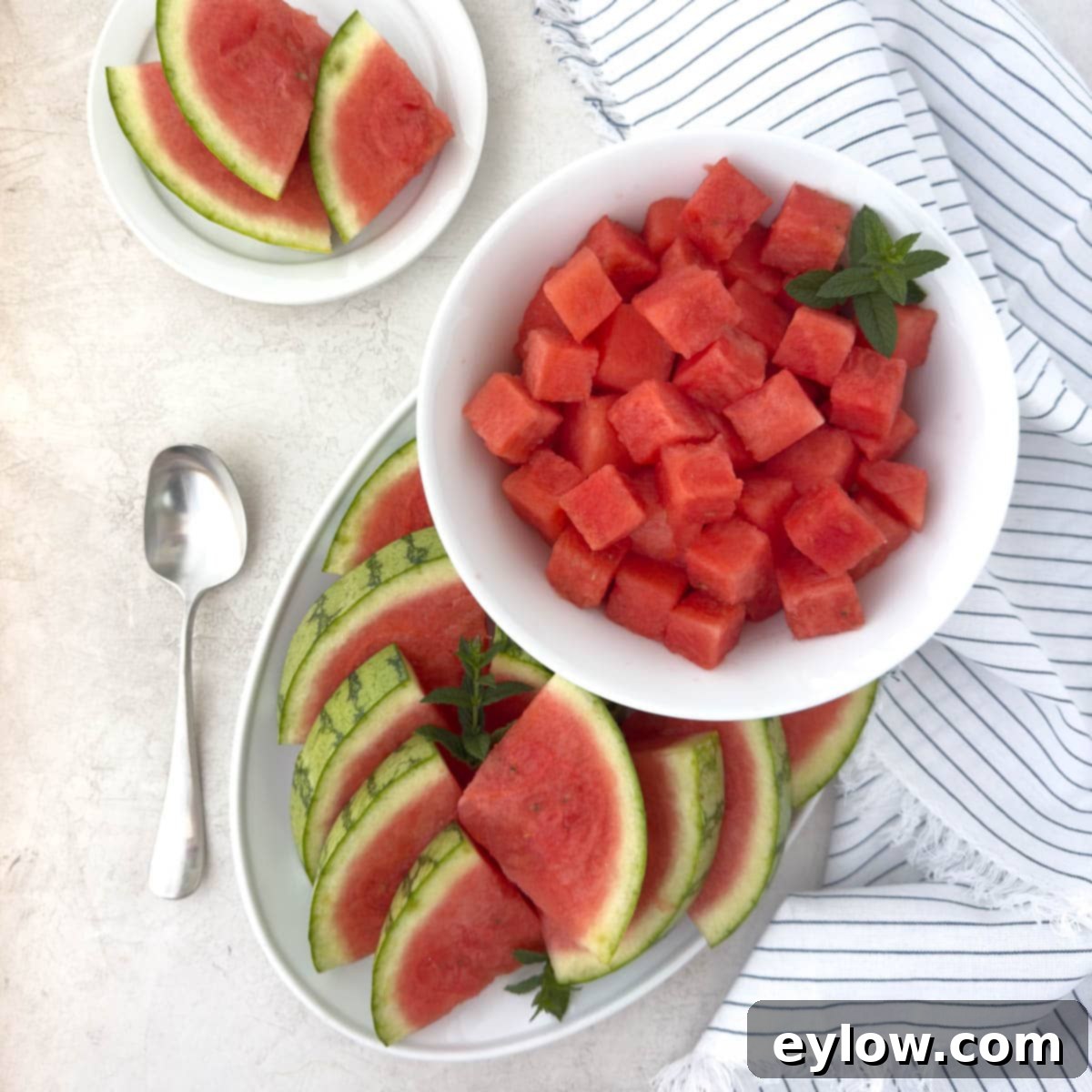Mastering Watermelon: Your Ultimate Guide to Perfectly Cut Cubes, Slices, and Sticks
Fresh watermelon is an iconic symbol of summer, offering a hydrating and sweet escape from the heat. Comprising over 90% water, it’s the ultimate natural refresher. However, its large, round, and often heavy nature can make the task of cutting it seem daunting. Many shy away from buying whole watermelons due to this challenge, opting for pre-cut versions that might sacrifice freshness and cost more. But what if you could effortlessly transform a whole watermelon into beautiful, manageable pieces right in your own kitchen? This comprehensive guide will show you exactly how to cut watermelon like a pro, step-by-step, into versatile watermelon cubes, elegant triangle-shaped slices, and fun watermelon sticks. Get ready to impress your family and friends with perfectly prepared watermelon all summer long!
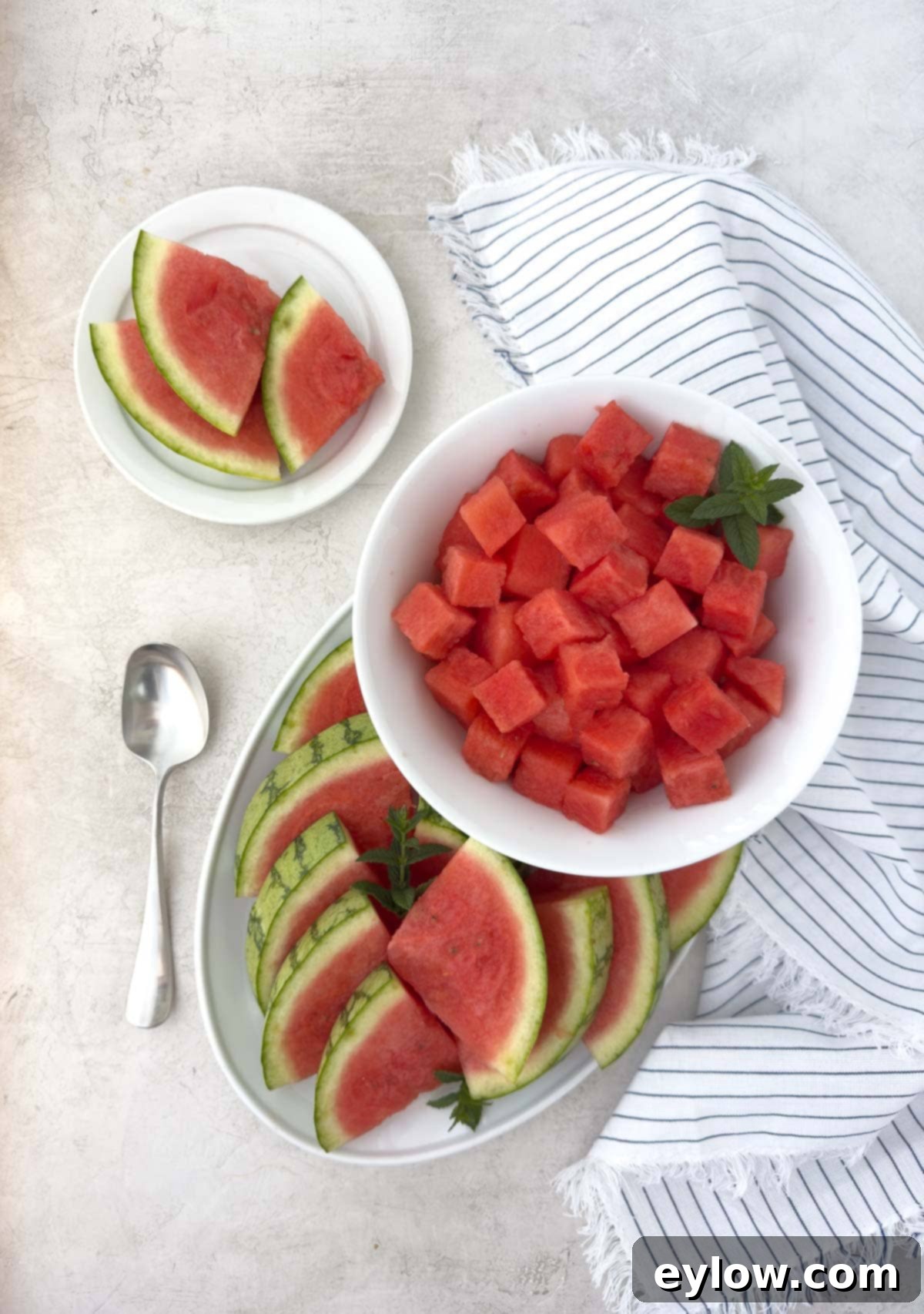
The secret to simplifying the process lies in having the right tools and knowing a few clever techniques. You’ll need a large, sharp chef’s knife to navigate through the sturdy rind and a spacious, stable cutting board. While the idea of tackling a whole watermelon might seem intimidating at first, these simple tips will make it surprisingly easy and even provide excellent practice for your knife skills. Don’t let its size deter you any longer! By following these three distinct methods for cutting watermelon, you’ll quickly become a master, ready to enjoy this delightful fruit in any form you desire.
Why You’ll Love This Comprehensive Watermelon Cutting Guide
Learning how to cut watermelon yourself offers numerous advantages, ensuring you get the freshest, most delicious fruit every time. This tutorial will empower you to:
- Enjoy Peak Freshness and Flavor: When you buy a whole watermelon, you control when it’s cut, ensuring maximum freshness and optimal flavor. Pre-cut options often lose their vibrant taste and texture quicker.
- Master Versatile Cuts for Any Occasion: Discover the best methods to transform a whole watermelon into perfectly sized watermelon cubes for snacking, fruit salads, or smoothies. You’ll also learn to create elegant triangle wedges ideal for fruit platters and gatherings, and fun watermelon sticks perfect for kids and easy grab-and-go enjoyment.
- Maximize Value and Reduce Waste: Buying whole watermelons is typically more cost-effective than purchasing pre-cut containers. By cutting it yourself, you can utilize the entire edible portion, customize portion sizes, and even repurpose scraps for juices or smoothies, minimizing waste.
- Gain Confidence in the Kitchen: Tackling a large fruit like a watermelon can significantly boost your kitchen confidence and refine your knife skills. Our clear, step-by-step instructions ensure a safe and successful cutting experience.
Once you’ve mastered cutting, why not try incorporating watermelon into more dishes? This refreshing watermelon appetizer with goat cheese offers a delightful sweet and savory bite, perfect for summer entertaining.
Essential Tools for Watermelon Preparation
While this isn’t a traditional “recipe,” having the right tools makes all the difference when tackling a whole watermelon. For effortless and safe cutting, you’ll primarily need a good knife and a stable surface:
- Large, Sharp Knife: The most crucial tool is a big, sharp chef’s knife. Its length and sturdy blade are essential for cleanly cutting through the thick rind. Some people prefer a long serrated slicer, which can grip the tough outer skin more easily, or even an inexpensive watermelon knife designed specifically for this purpose. Whatever you choose, ensure it’s well-sharpened for safety and efficiency.
- Sturdy Cutting Board: A large, stable cutting board is vital. Watermelons are big and juicy, so you’ll need ample space to work safely. To prevent the board from slipping, always place a damp kitchen towel or non-slip mat underneath it. This small step significantly enhances stability and reduces the risk of accidents.
- Optional: Melon Baller: For decorative spheres, a melon baller can be a fun addition to your toolkit.
When it comes to the watermelon itself, I often opt for seedless mini watermelons, which typically weigh between 5-6 pounds. Their smaller size makes them easier to handle and cut. However, the methods described below are fully adaptable for cutting up whole watermelon of any size, including larger varieties or even the half watermelons sometimes sold in grocery store produce departments. If you’re unsure how to pick the perfect watermelon, don’t worry – we’ve included expert tips towards the end of this post!
Step-by-Step Watermelon Cutting: The Foundation
Before diving into specific shapes, there are a few foundational steps that apply to all cutting methods. Prioritizing safety and stability will make the entire process smoother and more enjoyable:
- Prepare Your Workspace: Begin by placing a damp kitchen towel or a non-slip mat directly under your cutting board. This simple yet crucial step prevents the board from sliding, providing a stable and secure surface for cutting.
- Wash the Watermelon: Even though you won’t eat the rind, it’s important to wash the whole watermelon thoroughly under cool running water, scrubbing gently with a produce brush if you have one. This removes any dirt or bacteria from the surface that could be transferred to the flesh by your knife.
- Create a Stable Base (The First Cut): Carefully slice a thin piece off one end of the watermelon, creating a flat, stable surface. This initial cut is key to preventing the round fruit from rolling while you continue cutting.
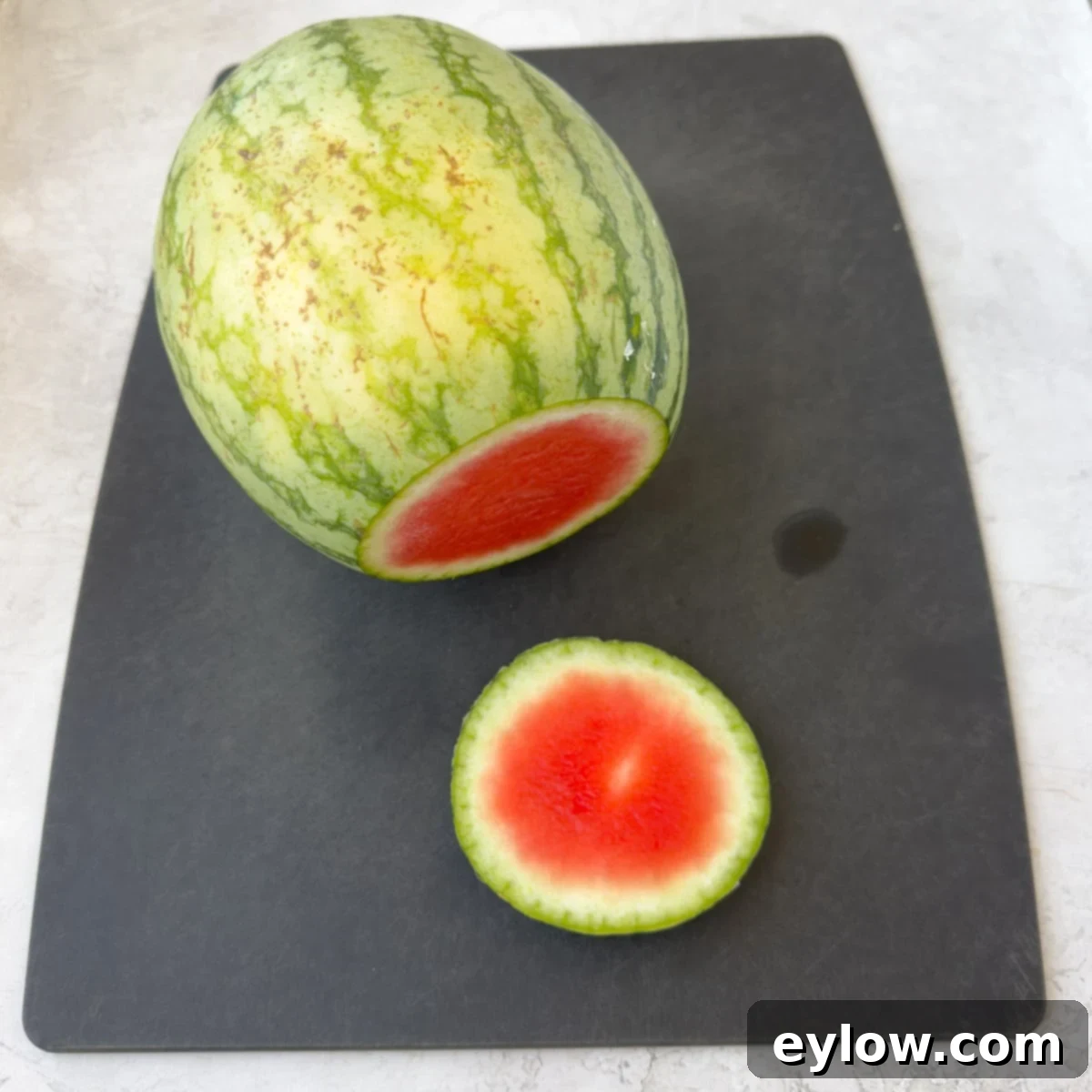
- Halve the Watermelon: Stand the watermelon on the newly created flat surface. Carefully cut it in half from top to bottom, using a firm, even motion. You should now have two equal watermelon halves, revealing the vibrant red flesh. From this point, you can choose whether you want watermelon cubes, watermelon slices, or watermelon sticks.
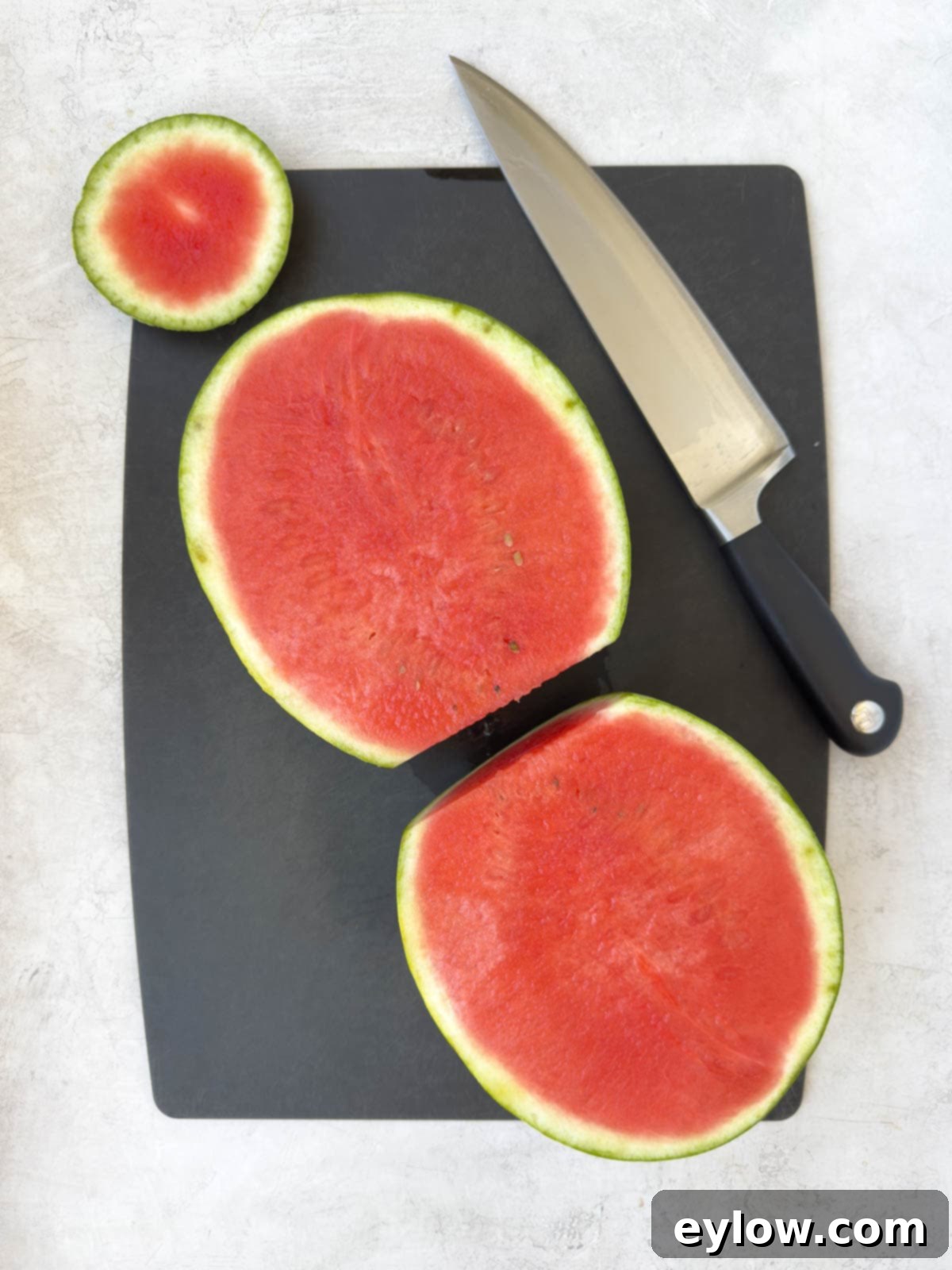
How to Cut a Watermelon Into Perfect Cubes
Watermelon cubes are incredibly versatile for snacking, adding to salads, or freezing for smoothies. Here’s the easiest way to achieve uniform cubes:

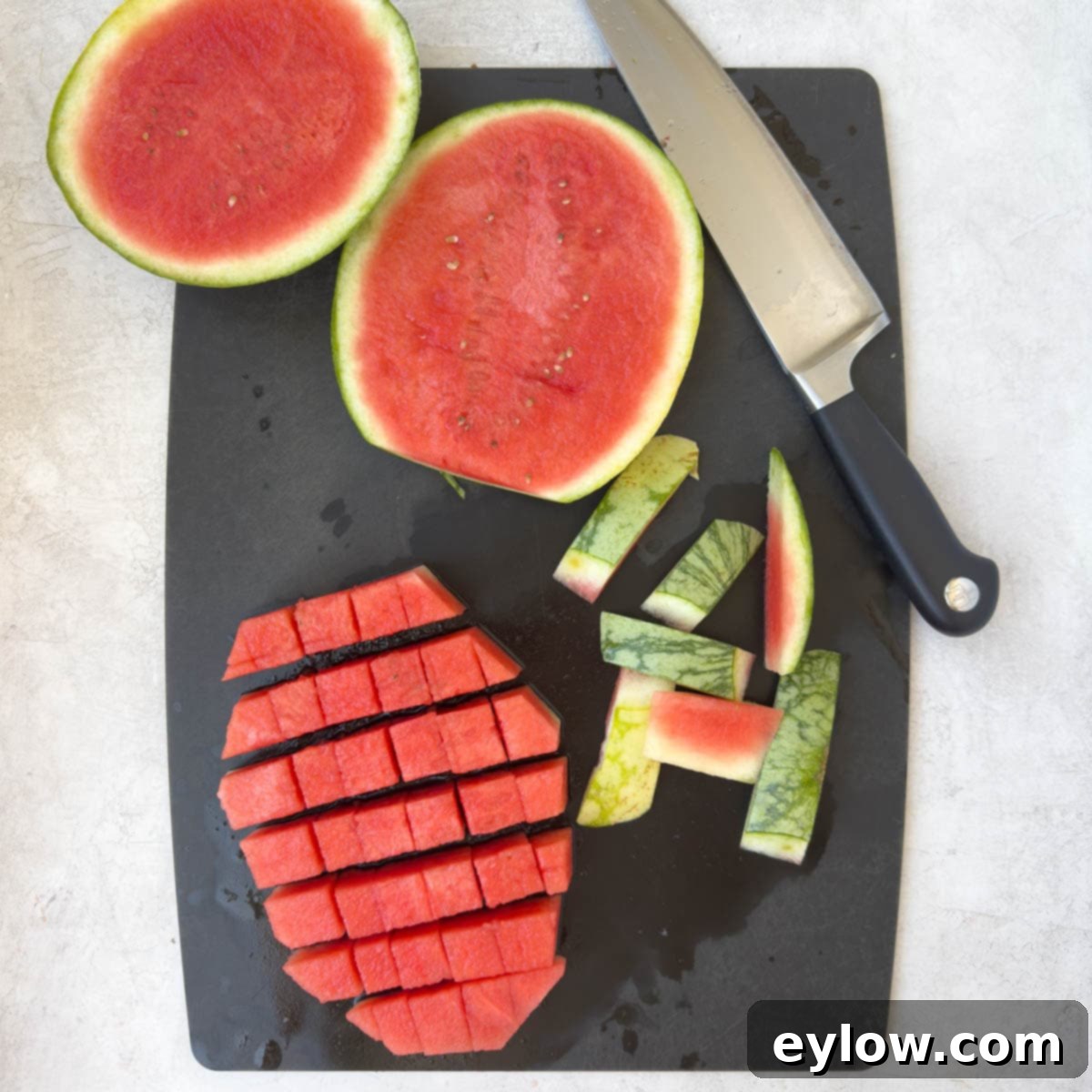
- Slice into Large Strips: Take one of your watermelon halves and place it cut-side down on your cutting board. Carefully make long, vertical slices from top to bottom, about 1 to 1.5 inches thick, depending on your desired cube size.
- Remove the Rind: Lay each watermelon slice flat on the cutting board. Using your knife, carefully trim away the green and white rind from all sides of each slice. You should be left with pure red watermelon flesh.
- Dice into Cubes: Stack a few rind-free watermelon slices on top of each other. Cut them horizontally into strips of the same width (1 to 1.5 inches). Then, rotate the stacked strips 90 degrees and cut vertically again, creating a grid pattern that yields beautiful, uniform watermelon cubes.
- Adjust for Size: For smaller cubes, make your initial slices and subsequent cuts closer together. For larger, chunkier pieces, simply increase the width of your cuts.
Cutting Watermelon Slices or Wedges
Classic watermelon slices or wedges are perfect for a fruit platter or for eating directly off the rind. This method is quick and satisfying:

- Quarter the Melon: Take one of your halved watermelons and place it cut-side down. Cut it in half again lengthwise, creating two quarter-sections. Repeat with the other half, so you have four manageable quarter-melons.
- Slice into Triangles/Wedges: Lay a quarter-melon flat on your cutting board. Make crosswise slices, about 1 inch thick, from the tip to the rind. Each slice will naturally form a triangular wedge, complete with a portion of the rind acting as a convenient handle.
- Uniformity: For aesthetically pleasing slices, try to keep your cuts consistent in thickness. These triangle watermelon slices are perfect for serving at picnics or BBQs.
How to Cut Watermelon Sticks for Easy Snacking
Watermelon sticks are incredibly popular, especially for children, as they are easy to hold and eat without making a mess. This method is ingenious and yields visually appealing results:
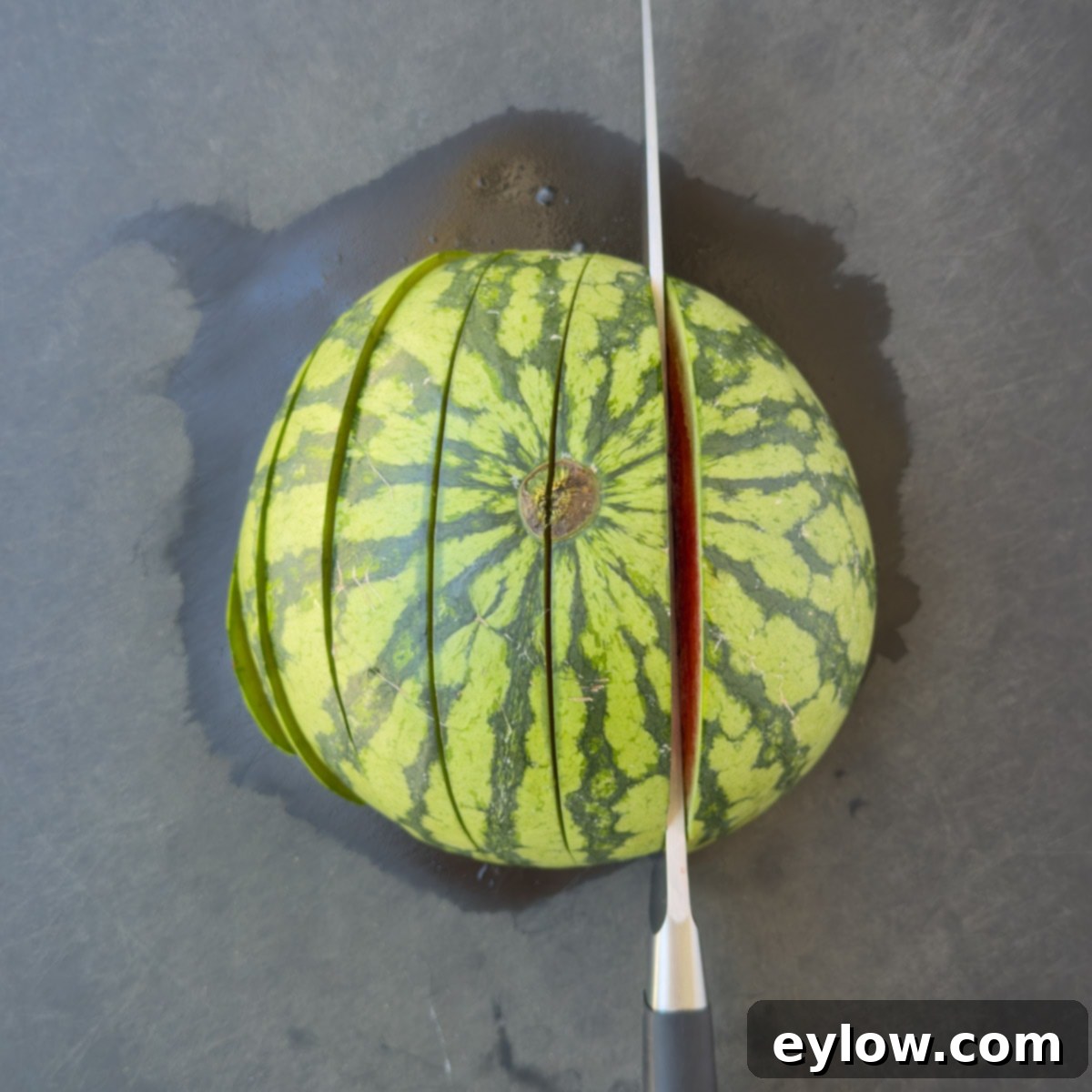
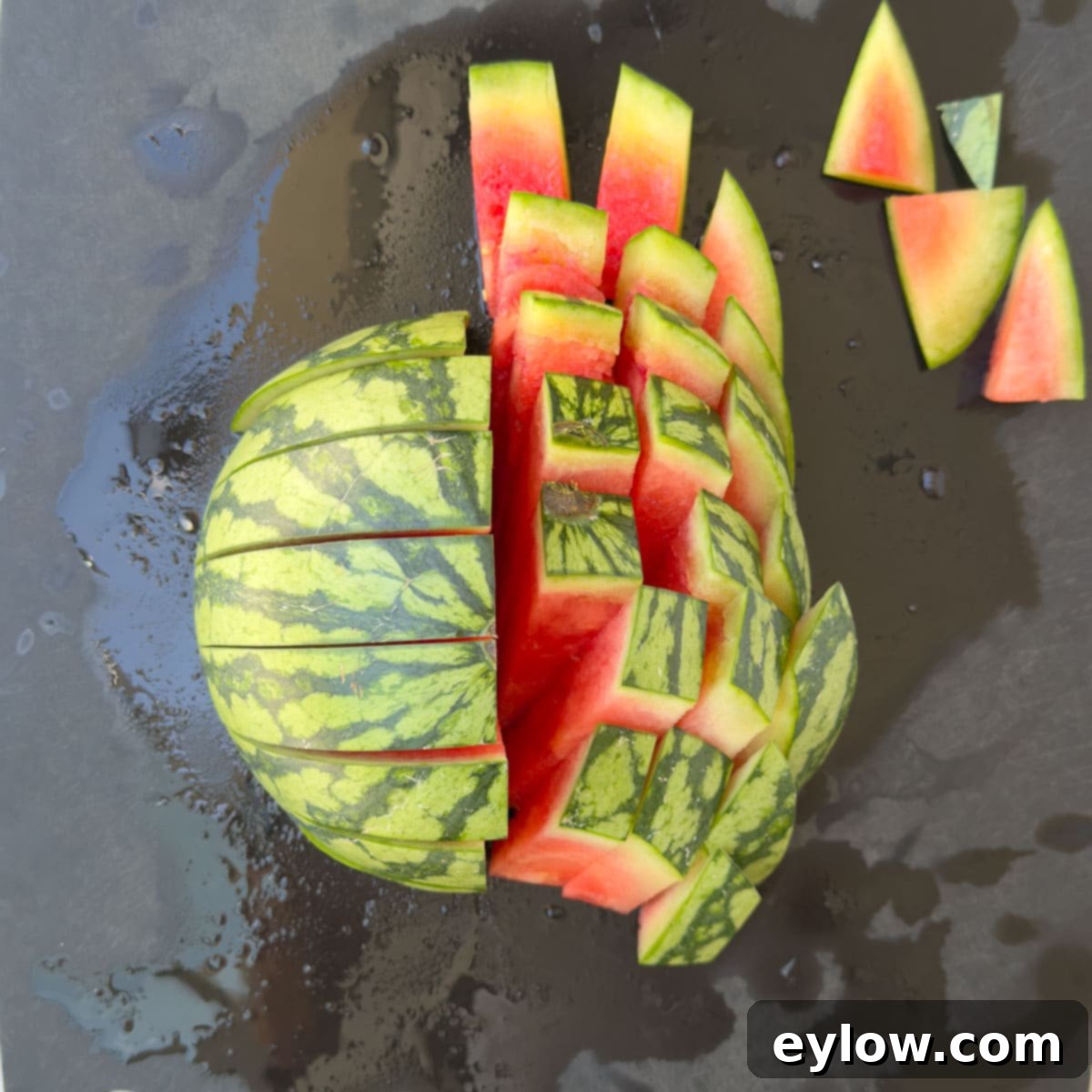
- Initial Crosswise Slices: Take one of your watermelon halves and place it cut-side down on your cutting board. This allows the rind to act as a natural, stable base. Carefully cut the watermelon crosswise into 1-inch thick slices, stopping just short of cutting through the rind completely. You want the rind to remain intact at the bottom, holding the slices together like a fan.
- Create the Grid: Rotate the melon half 90 degrees. Now, make parallel cuts, again about 1 inch apart, in the opposite direction. Again, cut down to the rind but don’t cut through it. This creates a grid pattern within the watermelon half.

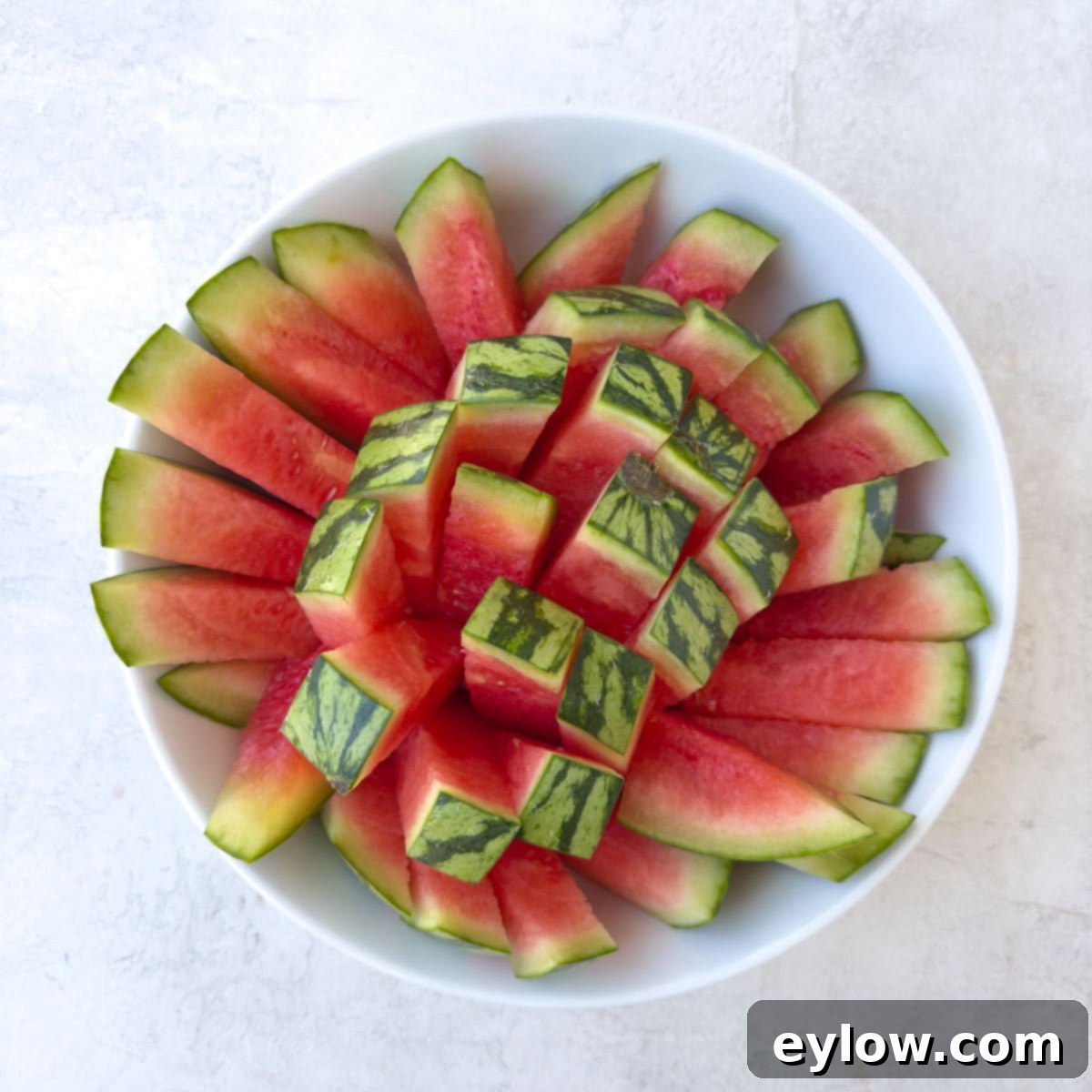
- Serving Watermelon Sticks: To serve, simply pick up the entire watermelon half and invert it into a serving bowl or platter. The individual watermelon sticks will easily pull apart, and the rind conveniently acts as a handle for each piece.
Chef’s Note on Cutting Watermelon Sticks: If, after making your grid cuts, the melon pieces start to become unstable or fall apart, simply lay the melon half flat again. You can then carefully cut each slice individually into sticks, removing the rind from each stick as you go. This ensures clean, easy-to-handle pieces. Reassemble them on a platter if you want that impressive “melon half” presentation!
Creative Ways to Enjoy Your Freshly Cut Watermelon
Now that you’ve mastered how to cut watermelon into various shapes, the possibilities for enjoying this delicious fruit are endless. Here are some inspiring serving suggestions:
- Party Platters and Fruit Salads: Arrange beautiful watermelon wedges or triangles alongside other seasonal fruits for an eye-catching and refreshing platter. Watermelon cubes are a perfect addition to any mixed fruit salad, adding sweetness and hydration.
- Delicious Fresh Fruit Kabobs: Use a melon baller to create perfectly round watermelon balls. Thread them onto skewers with other colorful fruits like cantaloupe, honeydew, and grapes for vibrant and easy-to-eat fruit kabobs. Don’t waste the extra melon scraps – toss them into a blender for a quick and refreshing melon water.
- Savory Watermelon Salads: Combine watermelon cubes with crumbled feta cheese, fresh mint or basil, and a drizzle of balsamic glaze for an incredibly refreshing and healthy summer salad. The sweet, salty, and herbaceous flavors create a delightful balance.
- Enhance Green Salads: Add small watermelon cubes to a tossed green salad for a burst of unexpected sweetness and juicy texture. It pairs wonderfully with arugula, goat cheese, and a light vinaigrette.
- Fun Shapes for Kids and Events: For a more playful presentation, use large cookie cutters to cut shapes (stars, hearts, flowers) from thick watermelon slices. These are fantastic for children’s parties or adding a whimsical touch to any platter.
- Frozen Watermelon Treats: Freeze watermelon cubes and add them to your favorite smoothies for a natural sweetener and thickener, eliminating the need for ice. Alternatively, blend frozen cubes with a splash of lime juice for an instant, guilt-free watermelon slushie.
- Hydrating Watermelon Beverages: Puree fresh watermelon in a blender, strain it, and add fresh lime juice for an authentic Mexican watermelon water (Agua Fresca). For another incredibly refreshing drink, try making watermelon cucumber juice, a fantastic way to stay hydrated.
- Kid-Friendly & BBQ Perfect: Watermelon, especially in stick form, is a universally loved, kid-friendly snack. It’s also an absolute must-have for any summer backyard barbecue or picnic.
For your reference, watermelons are typically about 70% flesh and 30% rind. A 5-pound mini watermelon generally yields enough fruit to serve approximately 8 people. For more fascinating facts and information about this incredible fruit, visit the National Watermelon Promotion Board website.
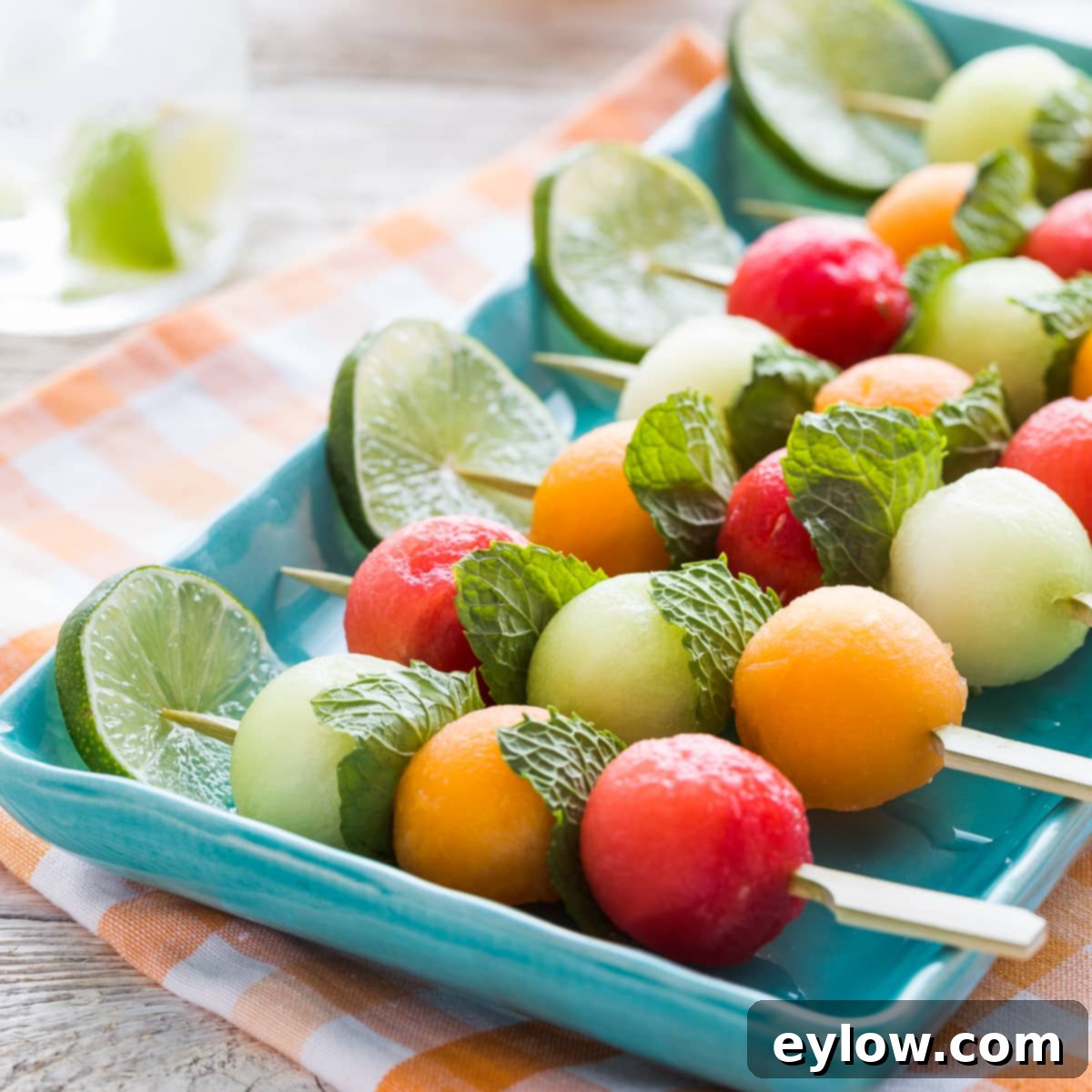
How to Select the Sweetest, Juiciest Watermelon
Before you even think about how to cut watermelon, you need to know how to pick a good watermelon at the market. Choosing a ripe, juicy, and sweet watermelon can feel like a guessing game, but with these simple tips, you’ll select a winner every time:
- Shape and Firmness: Look for a watermelon that is firm to the touch and has a regular, symmetrical shape. Avoid melons that are oddly shaped, lumpy, or narrow at one end, as this can indicate inconsistent growth and uneven sweetness.
- Check for Blemishes: Inspect the rind for any major bruises, soft spots, dents, or deep cuts. Minor scratches or superficial imperfections are usually normal and don’t affect the quality of the fruit inside.
- The All-Important Field Spot: This is arguably the most reliable indicator of ripeness. Look for a large, creamy yellow to orange patch on the underside of the watermelon. This “field spot” (or ground spot) is where the melon rested on the ground and ripened in the sun. A creamy yellow or orange color suggests the melon was allowed to ripen longer on the vine, resulting in a sweeter, more flavorful fruit. Avoid watermelons with no spot, or those where the spot is white or pale green, as they are likely underripe and won’t get sweeter after harvesting.
- Dull Rind: A ripe watermelon will typically have a dull, matte appearance on its rind, rather than a shiny one. A shiny rind often indicates that the melon is not yet fully ripe.
- Heavy for Its Size: Pick up a few watermelons of similar size and compare their weight. A ripe watermelon should feel noticeably heavy for its size. This weight indicates high water content, meaning the melon is juicy and well-hydrated.
- The “Thump” Test: If you’re accustomed to thumping melons, listen for a deep, hollow sound when you tap it. This resonant sound suggests that the flesh inside is perfectly ripe and full of water. An unripe watermelon will often produce a duller, higher-pitched sound.
My personal favorites are seedless mini watermelons. They are not only easier to handle and transport due to their smaller size but often have thinner rinds, making them considerably easier to cut than their larger counterparts. Plus, no pesky seeds to worry about!
Storing Watermelon for Maximum Freshness
To ensure your watermelon retains its delicious taste and texture, proper storage is key. Aim to consume fresh watermelon as soon as possible for the best flavor, but here’s how to store it effectively:
- Whole, Uncut Watermelon: As soon as you bring your watermelon home, give it a good wash with produce wash or plain water to remove any dirt or surface bacteria. Store whole, uncut watermelons in a cool, dark place, such as a pantry, for up to a week. For longer storage (up to two weeks), refrigerate the whole melon.
- Room Temperature vs. Refrigeration: If you plan to enjoy your watermelon within a day or two, it’s perfectly fine to keep it on the kitchen counter at room temperature. This can even enhance its flavor slightly. However, for any period longer than 48 hours, refrigeration is best until you’re ready to cut it.
- Cut Watermelon Storage: Once cut, watermelon must be refrigerated. For larger pieces like quarters or halves, tightly wrap the exposed cut surfaces with plastic wrap to prevent them from drying out and absorbing other odors from the fridge. For watermelon cubes, slices, or sticks, store them in an airtight container. Properly stored, cut watermelon will maintain its freshness for 3-4 days in the refrigerator.
- Pre-Cut Watermelon from the Market: If you purchase pre-cut watermelon from the grocery store, be sure to check the date sticker to ensure it’s fresh. Always ask a produce associate if you have any doubts about its freshness or origin. Consume pre-cut melon quickly, as its shelf life is generally shorter than freshly cut whole fruit.
Frequently Asked Questions About Watermelon
When considering watermelon’s impact on blood sugar, it’s important to distinguish between glycemic index (GI) and glycemic load (GL). Watermelon has a relatively high glycemic index, typically scoring between 76-80 on a 1-100 scale, which might suggest high sugar content. However, the glycemic load (GL) provides a more accurate real-life picture of a food’s effect on your blood sugar, as it accounts for portion size. For watermelon, the glycemic load is surprisingly low, often listed as just 5 on a 1-10 scale. This means that while the sugar in watermelon is quickly absorbed, the actual amount of sugar per typical serving is not high enough to cause a significant spike in blood sugar. Therefore, watermelon can be a sweet, hydrating, and nutritious part of a balanced summer diet, even if you are mindful of sugar intake. For more information, you can refer to resources like Harvard Health.
The easiest and safest way to begin cutting a watermelon involves creating a stable base. First, slice a thin piece off one of the ends of the watermelon so it can stand upright without rolling. Next, place the watermelon on this flat end and cut it in half from top to bottom. This gives you two stable halves. From there, you can easily proceed to slice them into wedges, cut them into cubes, or create convenient sticks. Many find that starting with a mini watermelon simplifies the entire process due to its more manageable size compared to a full-sized melon.
Cut watermelon, whether in halves, quarters, wedges, or cubes, should be stored in the refrigerator. If you have larger pieces like halves or quarters, tightly wrap the cut surfaces with plastic film to prevent them from drying out. For smaller pieces like wedges and cubes, transfer them to an airtight container. When stored properly in this manner, cut watermelon will typically remain fresh and delicious for 3-4 days.
Absolutely, you can eat watermelon seeds! They are not only safe but also quite nutritious, packed with protein, healthy fats, magnesium, and zinc. The black seeds found in traditional watermelons are mature and fully developed; you can even plant them to grow new watermelons! These black seeds can also be roasted and enjoyed as a crunchy snack, similar to pumpkin seeds. The small, white “seeds” you often find in seedless watermelons are actually immature, undeveloped seeds or “pips,” which are soft and completely edible, often going unnoticed as you eat the fruit.
Yes, seedless watermelons are completely natural. They are not the product of genetic modification or bio-engineering. Instead, seedless watermelons are cultivated through a traditional cross-breeding process. Farmers cross a watermelon plant with 22 chromosomes per set (a diploid) with a watermelon plant that has been treated to have 44 chromosomes per set (a tetraploid). The resulting hybrid seeds grow into a plant that produces sterile fruit with 33 chromosomes per set (a triploid), which means it cannot produce viable seeds itself, leading to the “seedless” watermelons we enjoy today. This method is a form of hybridization, similar to how mules are bred, and is a natural agricultural practice.
Discover More Delicious Summer Recipes
Make the most of the season’s bounty with these fantastic summer recipes, perfect for complementing your freshly cut watermelon:
- Gazpacho Andaluz (Spanish Chilled Tomato Soup
- Fresh Pineapple Mango Salsa Recipe
- Quick and Simple Grilled Zucchini
- Zucchini Gratin with Parmesan Crust
⭐️Did This Tutorial Help You?
We hope this comprehensive guide on how to cut watermelon has empowered you to confidently tackle this delicious fruit! If you found these tips and techniques useful, please share your experience by leaving a comment below. Your feedback is truly appreciated and helps other readers. If you loved it, don’t forget to give it a 5-star rating!
📖 Recipe
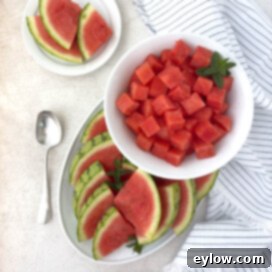
How to Cut Watermelon
Sally Cameron
Pin Recipe
Equipment
-
Large Chef’s Knife (or serrated slicer)
-
Large, Sturdy Cutting Board
-
Damp Kitchen Towel (for stability)
Ingredients
- 1 whole seedless watermelon (approx. 5-6 pounds for mini, or any size, heavy for its size)
Instructions
General Preparation for all cuts:
-
Wash the watermelon thoroughly. Place a damp kitchen towel under your cutting board for stability.
-
Using a large, sharp knife, trim a thin slice off one end of the watermelon to create a flat, stable base.
-
Stand the watermelon on this flat end and carefully cut it in half from top to bottom, dividing it into two equal halves.
For Watermelon Slices/Wedges (Triangles):
-
From a watermelon half, lay it cut-side down. Cut it in half again lengthwise, creating two quarter-sections.
-
Lay a quarter-melon flat. Slice crosswise into 1-inch thick triangles or wedges, allowing the rind to remain as a handle.
For Watermelon Cubes:
-
From a watermelon half, lay it cut-side down. Cut into long, 1 to 1.5-inch wide slices from top to bottom.
-
Lay each slice flat and carefully trim off all the rind.
-
Cut the rind-free flesh into a grid pattern of your desired cube size (e.g., 1-inch strips, then 1-inch cubes).
For Watermelon Sticks:
-
Take one watermelon half and lay it cut-side down on the cutting board.
-
Cut a 1-inch grid across the entire watermelon half, making sure to cut down to the rind but not through it.
-
To serve, gently invert the watermelon half into a serving bowl or platter. The individual sticks will separate easily, with the rind acting as a natural handle for each piece.
